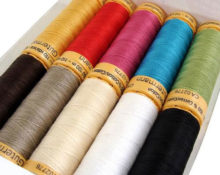Textured thread consists of twisted fibers, which makes it impossible for them to be tightly laid in a complex thread. Thanks to the loose structure, it is possible to achieve greater elasticity and softness without compromising characteristics such as strength and wear resistance.
Types and technology of production
All types of textured thread have different performance characteristics and are produced in fundamentally different ways.

High tensile (elastic, helanka) - the result of twisting, thermal fixation and subsequent unwinding of a complex synthetic thread.
Low stretch (meron, melan, saabo, astralon) - the fruit of additional heat treatment of the previous version, they are distinguished by their fluffiness.
Twisted (corrugated, banlon, reelon, ajilon) are most often produced by pulling a plate along a hot blade, as a result of which the fibers become spiral-shaped. The second option is to weave the fabric, heat fix it and then unravel it.
Loopy (aeron, taslan) are obtained by “rattling” the fibers of a complex thread with a stream of air.
Profiled can be compared to curly pasta. This is either a hollow shell or a corrugated outer part, which is obtained as a result of molding through a die with a figured cross-section.
Bicomponent — consist of several fibers with different shrinkage. After drawing, they undergo heat treatment, as a result of which some polymers are shortened more than others, giving a crimped bulky thread with a loose structure.
Combined - several types of threads twisted into one.
High bulk yarn produced using a technology similar to bicomponent ones. The only difference is that it is not the tensioned thread that undergoes heat treatment, but the free thread. The result is a fluffy thread with normal stretchability.
Where are they used?

The main task of texturing is to impart natural properties to chemical fiber: increasing hygroscopicity, eliminating shine, and softness. Since the goal has been successfully achieved, such threads have a wide range of applications. This includes knitwear and textiles, faux fur and even carpets and blankets. In sewing, such a thread is indispensable when sewing items made from stretchy fabrics - the seam is soft and “springy”, which increases the durability of such clothes. But it is important to understand that you should not pass the textured thread through the eye of the needle - it is only threaded into the looper.


 0
0





